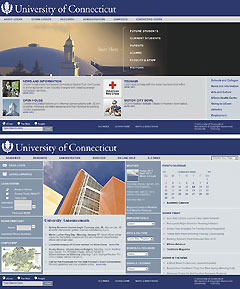New UConn Homepage Designed for Easy Navigation
 |
|
The new UConn homepage, top, has links to specialized webpages for key University audiences. Also shown is the new faculty and staff page. |
The UConn website is getting a makeover, but the change is more than cosmetic. With special pages tailored to different audiences, the new website is designed to be more functional and easier to use.
“We’re changing the orientation of the University’s homepage,” says John Barry, director of university communications. “There will continue to be a single UConn homepage, but its focus will change.”
The new homepage – www.uconn.edu– to be launched today, asks users of the site to identify themselves as belonging to one of a number of key user groups: future students, current students, parents, alumni, faculty and staff, and visitors.
Clicking on one of these identities will take the user to a new page – similar to the student page implemented in 2003 – that is specially designed to meet the needs of the specific group. Links from that page will then take users directly to the types of information they are most likely to be looking for, although each of the pages will also allow users to search any part of the University’s website.
The new homepage also includes links to the websites for schools and colleges, arts and culture, the Health Center, the UConn Foundation, athletics, and employment opportunities.
The special faculty/staff webpage – www.uconn.edu/facultystaff – also goes “live” Jan. 18, and pages for the other groups will be completed over the next several months. Each has a consistent design – a unified visual identity – that includes the UConn logo and photographs of scenes from University life, but the selection of pictures varies according to the intended audience.
“The University’s web philosophy has evolved over time,” says Barry. “At one time, we didn’t know exactly who was using our website. All we could do was imagine the various audiences and try to offer something for everyone.”
Through research that has included focus groups and surveys, the university communications department has identified the core set of information that each web user group is most likely to be seeking. The result is a series of user-friendly pages tailored to each audience.
“If you’re a current student, you’re looking for 10 or 15 things most of the time,” says Barry. “The same if you’re a faculty member, a staff person, an alumnus or a parent. So we’ve done our homework and identified what those 10 or 15 things are for each group. With the new webpages, we’ve made the appropriate information for each audience most accessible.”
The faculty/staff webpage allows users to log in to e-mail, PeopleSoft, and WebCT, and link to the University Libraries and school, college, and department websites. It includes a University phone directory, campus maps, and an announcements section, along with links to a variety of University forms and other resources. A news section highlights faculty research that has been cited in the media in Connecticut and around the world.
The new webpages are based on the approach used in creating the student webpage – students.uconn.edu– a site that has received as many as 80,000 “hits” a day since it was launched in August 2003.
“The student page has just about everything you want, right there in one place for you,” says Kim Chambers, director of the Instructional Resource Center.
“Until we had the student webpage, we had no direct mechanism for providing information to current students,” says Barry. “In focus groups with current students, they told us they preferred web-based communications and said, ‘If you gave us something useful enough, we would pay attention to what you want to tell us.’”
Consistent with students’ interests, that page now includes information about the weather, Dining Services menus, bus schedules, and movie channel listings; and a daily bulletin board of information called “Did You Know” that offers announcements ranging from athletic ticket sales to computer virus alerts and class cancellations owing to weather. There are also links to the events calendar, and to PeopleSoft, WebCT, and Huskymail.
Barry says research shows that people are still using traditional sources of information, such as magazines and newspapers, as primary sources of information about the University, but there is a steady increase in use of the web.
“While our communications programs in recent years have been achieving their objectives,” says Barry, “we now need to expand the variety of electronic communications in our strategic communications repertoire.” Student recruitment efforts, for example, developed in conjunction with the admissions office, will increasingly focus on web-based and other forms of electronic communication.
The student page has been so successful that a number of other members of the University community have tailored their web browser to go directly to the site. As the faculty/staff webpage goes live, these users may find a page specially tailored to their interests and needs even more useful.
A button on the faculty/staff webpage allows users to set their web browser to that page as the default setting.
“We’re hoping to see a great number of hits on the new site,” says Barry. “Many faculty and staff provided useful information as we were creating the page. Now we hope to see numbers that indicate we’ve created something of value to the entire community of faculty and staff.”

